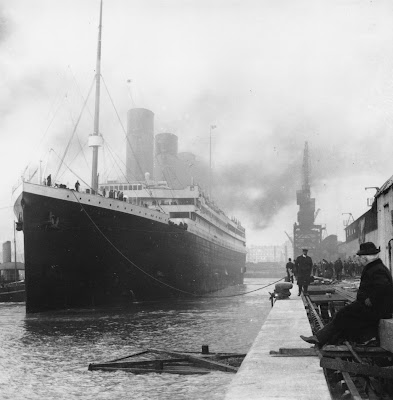Artist Dave Olson performs today at the grave of pop artist Andy Warhol while being recorded by reporter Travis Larchuk for an upcoming NPR segment. (Scott Beveridge photo)
By Scott Beveridge
BETHEL PARK, Pa. – Andy Warhol's otherwise plain tombstone stands out from the road wrapped in colorful paper and lined with bouquets of silk flowers, gifts left behind as more and more of his fans make pilgrimages to his grave.
Some visitors offer gifts of small plastic skulls while others come to dance or "talk" to the pop artist buried in St. John the Baptist Byzantine Catholic Church off Route 88 in Bethel Park.
"There is something significant going on here beyond Andy's grave," said Dave Olson, a retired art professor from Rostraver Township, while stopped by the grave today to play bagpipes for Warhol.
"They're paying homage, satisfying their curiosity and people are having fun. We've danced on his grave, literally," said Olson, who taught at California University of Pennsylvania.
He's been coming here regularly for three years as part of a project named "Figments: Conversations with Andy," undertaken by Madelyn Roehrig, a program manager at Carnegie Museum of Art in Pittsburgh.
As a personal endeavor, she stops by Warhol's grave every day as an obsession to document the site for films she produces, once of which aired recently on WQED in Pittsburgh. Warhol, who died Feb. 22, 1987, of complications from gallbladder surgery, is buried at the feet of the graves of his parents, Andrew and Julia Warhola.
"He's inspiring," Roehrig said. "He gives me something to do."
Tagging along with Roehrig is Travis Larchuk, an NPR journalist from Washington, D.C., who is creating a segment for a show on the graves of famous people and is much too shy to say anything to Warhol.
Aside from the gift of music, Olson has brought along a toy pistol he molded with rubber for Warhol.
"Knowing how much he hated gun violence It motivated me to make this rubber gun. It's much less dangerous," Olson said.
Roehrig said she likely will take home the gun and add it to her collection of weird things people leave behind at the grave. The oddest thing she retrieved from here is a small plastic penis, she said.
The family likely made the choice to mark the grave with a small, nondescript tombstone, Roehrig said.
"He liked ordinary things. I don't know," she said.
But, since April, Paul LeRoy "King of Art" Gehres of Millvale has been framing the grave marker with wrapping paper, first in shades of red and white, and now with stripes of blue, white and lime green.
"It's pretty ordinary, or it used to be. It's just what it needed," Roehrig said.
Scattered on the ground are plastic easter eggs and one playing card, a four and "a half" of hearts. Whatever that means. Atop the stone are three unopened Campbell's tomato soup cans, a can of chicken noodle soup, a 10-oz. bottle of Coca Cola and a golf ball.
At the graveside is a plastic folder, in which visitors leave behind letters to Warhol.
The most-recent one is written by Ellis, a 9-year-old who seeks the meaning of the wrapping paper. Ellis signed the note beside a drawing of a small red skull and crossbones.
Nearby the Siberian Iris are ready to bloom.
"There are a lot of references to what he did, who he interacted with," Olson said.
By Scott Beveridge
BETHEL PARK, Pa. – Andy Warhol's otherwise plain tombstone stands out from the road wrapped in colorful paper and lined with bouquets of silk flowers, gifts left behind as more and more of his fans make pilgrimages to his grave.
Some visitors offer gifts of small plastic skulls while others come to dance or "talk" to the pop artist buried in St. John the Baptist Byzantine Catholic Church off Route 88 in Bethel Park.
"There is something significant going on here beyond Andy's grave," said Dave Olson, a retired art professor from Rostraver Township, while stopped by the grave today to play bagpipes for Warhol.
"They're paying homage, satisfying their curiosity and people are having fun. We've danced on his grave, literally," said Olson, who taught at California University of Pennsylvania.
He's been coming here regularly for three years as part of a project named "Figments: Conversations with Andy," undertaken by Madelyn Roehrig, a program manager at Carnegie Museum of Art in Pittsburgh.
As a personal endeavor, she stops by Warhol's grave every day as an obsession to document the site for films she produces, once of which aired recently on WQED in Pittsburgh. Warhol, who died Feb. 22, 1987, of complications from gallbladder surgery, is buried at the feet of the graves of his parents, Andrew and Julia Warhola.
"He's inspiring," Roehrig said. "He gives me something to do."
Tagging along with Roehrig is Travis Larchuk, an NPR journalist from Washington, D.C., who is creating a segment for a show on the graves of famous people and is much too shy to say anything to Warhol.
Aside from the gift of music, Olson has brought along a toy pistol he molded with rubber for Warhol.
"Knowing how much he hated gun violence It motivated me to make this rubber gun. It's much less dangerous," Olson said.
Roehrig said she likely will take home the gun and add it to her collection of weird things people leave behind at the grave. The oddest thing she retrieved from here is a small plastic penis, she said.
The family likely made the choice to mark the grave with a small, nondescript tombstone, Roehrig said.
"He liked ordinary things. I don't know," she said.
But, since April, Paul LeRoy "King of Art" Gehres of Millvale has been framing the grave marker with wrapping paper, first in shades of red and white, and now with stripes of blue, white and lime green.
"It's pretty ordinary, or it used to be. It's just what it needed," Roehrig said.
Scattered on the ground are plastic easter eggs and one playing card, a four and "a half" of hearts. Whatever that means. Atop the stone are three unopened Campbell's tomato soup cans, a can of chicken noodle soup, a 10-oz. bottle of Coca Cola and a golf ball.
At the graveside is a plastic folder, in which visitors leave behind letters to Warhol.
The most-recent one is written by Ellis, a 9-year-old who seeks the meaning of the wrapping paper. Ellis signed the note beside a drawing of a small red skull and crossbones.
Nearby the Siberian Iris are ready to bloom.
"There are a lot of references to what he did, who he interacted with," Olson said.





